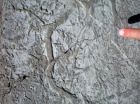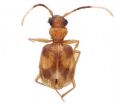(Press-News.org) Evolution of the first burrowing animals may have played a major role in stabilizing the Earth's oxygen reservoir, according to a new study in Nature Geoscience.
Around 540 million years ago, the first burrowing animals evolved. When these worms began to mix up the ocean floor's sediments (a process known as bioturbation), their activity came to significantly influence the ocean's phosphorus cycle and as a result, the amount of oxygen in Earth's atmosphere.
"Our research is an attempt to place the spread of animal life in the context of wider biogeochemical cycles, and we conclude that animal activity had a decreasing impact on the global oxygen reservoir and introduced a stabilizing effect on the connection between the oxygen and phosphorus cycles", says lead author Dr. Richard Boyle from the Nordic Center for Earth Evolution (NordCEE) at the University of Southern Denmark.
The computer modelling study by Dr. Richard Boyle and colleagues from Denmark, Germany, China and the UK, published in Nature Geoscience, links data from the fossil record to well established connections between the phosphorus and oxygen cycles.
Marine organic carbon burial is a source of oxygen to the atmosphere, and its rate is proportional to the amount of phosphate in the oceans. This means that (over geologic timescales) anything that decreases the size of the ocean phosphate reservoir also decreases oxygen. The study focuses on one such removal process, burial of phosphorus in the organic matter in ocean sediments.
The authors hypothesize the following sequence of events: Around 540 million years ago, the evolution of the first burrowing animals significantly increased the extent to which oxygenated waters came into contact with ocean sediments. Exposure to oxygenated conditions caused the bacteria that inhabit such sediments to store phosphate in their cells (something that is observed in modern day experiments). This caused an increase in phosphorus burial in sediments that had been mixed up by burrowing animals. This in turn triggered decreases in marine phosphate concentrations, productivity, organic carbon burial and ultimately oxygen. Because an oxygen decrease was initiated by something requiring oxygen (i.e. the activity burrowing animals) a net negative feedback loop was created.
Boyle states: "It has long been appreciated that organic phosphorus burial is greater from the kind of well oxygenated, well-mixed sediments that animals inhabit, than from poorly mixed, low oxygen "laminated" sediments. The key argument we make in this paper is that this difference is directly attributable to bioturbation. This means that (1) animals are directly involved in an oxygen-regulating cycle or feedback loop that has previously been overlooked, and (2) we can directly test the idea (despite the uncertainties associated with looking so far back in time) by looking for a decrease in ocean oxygenation in conjunction with the spread of bioturbation. My colleague, Dr Tais Dahl from University of Copenhagen, compiled data on ocean metals with oxygen-sensitive burial patterns, which does indeed suggest such an oxygen decrease as bioturbation began – confirming the conclusions of the modelling. It is our hope that wider consideration of this feedback loop and the timing of its onset, will improve our understanding of the extent to which Earth's atmosphere-ocean oxygen reservoir is regulated."
Co-author Professor Tim Lenton of the University of Exeter adds: "We already think this cycle was key to helping stabilise atmospheric oxygen during the Phanerozoic (the last 542 million years) – and that oxygen stability is a good thing for the evolution of plants and animals. What is new in this study is it attributes the oxygen stabilisation to biology – the presence or absence of animals stirring up the ocean sediments."
Earlier this year, researchers from the Nordic Center for Earth Evolution showed that early animals may have needed surprisingly little oxygen to grow, supporting the theory that rising oxygen levels were not crucial for animal life to evolve on Earth.
INFORMATION:
Reference
http://www.nature.com/ngeo/journal/vaop/ncurrent/full/ngeo2213.html
Contact
Dr. Richard Boyle.
rboyle@biology.sdu.dk
Burrowing animals may have been key to stabilizing Earth's oxygen
2014-08-06
ELSE PRESS RELEASES FROM THIS DATE:
Skull shape risk factors could help in the welfare of toy dog breeds
2014-08-06
New research has identified two significant risk factors associated with painful neurological diseases in the skull shape of the Cavalier King Charles Spaniel (CKCS). The findings could help in tackling these conditions in toy dog breeds and could be used in breeding guidelines.
The study conducted by undergraduate student, Thomas Mitchell, from the University of Bristol's School of Veterinary Sciences, and supervised by Dr Clare Rusbridge, is published online in the journal Canine Genetics and Epidemiology.
Syringomyelia (SM) is a painful condition in dogs and is ...
Aggressive behaviour increases adolescent drinking, depression doesn't
2014-08-06
Adolescents who behave aggressively are more likely to drink alcohol and in larger quantities than their peers, according to a recent study completed in Finland. Depression and anxiety, on the other hand, were not linked to increased alcohol use. The study investigated the association between psychosocial problems and alcohol use among 4074 Finnish 13- to 18-year-old adolescents. The results were published in Journal of Adolescence.
The results indicate that smoking and attention problems also increase the probability of alcohol use. Furthermore, among girls, early menarche ...
A synopsis of the carabid beetle tribe Lachnophorini reveals remarkable 24 new species
2014-08-06
An extensive study by Smithsonian scientists presents a synopsis of the carabid beetle tribe Lachnophorini. The research contains a new genus and the remarkable 24 new species added to the tribe. The study was published in the open access journal ZooKeys.
Beetles from the family Carabidae, commonly known as ground beetles are a large, cosmopolitan group, with more than 40,000 species worldwide, Carabid beetles range in size from 0.6 mm to 90.2 mm and occur in nature in several fractal universes influencing life therein as predators, ectoparasitoids, seed eaters, and even ...
Study: arctic mammals can metabolize some pesticides, limits human exposure
2014-08-06
Fortunately, you are not always what you eat – at least in Canada's Arctic.
New research from the University of Guelph reveals that arctic mammals such as caribou can metabolize some current-use pesticides (CUPs) ingested in vegetation.
This limits exposures in animals that consume the caribou – including humans.
"This is good news for the wildlife and people of the Arctic who survive by hunting caribou and other animals," said Adam Morris, a PhD student in the School of Environmental Sciences and lead author of the study published recently in Environmental Toxicology ...
New material structures bend like microscopic hair
2014-08-06
CAMBRIDGE, MA -- MIT engineers have fabricated a new elastic material coated with microscopic, hairlike structures that tilt in response to a magnetic field. Depending on the field's orientation, the microhairs can tilt to form a path through which fluid can flow; the material can even direct water upward, against gravity.
Each microhair, made of nickel, is about 70 microns high and 25 microns wide — about one-fourth the diameter of a human hair. The researchers fabricated an array of the microhairs onto an elastic, transparent layer of silicone.
In experiments, the ...
Coping skills help women overcome the mental anguish of unwanted body evaluation and sexual advances
2014-08-06
Some young women simply have more resilience and better coping skills and can shrug off the effect of unwanted cat calls, demeaning looks and sexual advances. Women with low resilience struggle and could develop psychological problems when they internalize such behavior, because they think they are to blame. So say Dawn Szymanski and Chandra Feltman of the University of Tennessee in the US, in Springer's journal Sex Roles, after studying how female college students handle the sexually objectifying behavior of men.
According to the popular feminist Objectification Theory, ...
Curing arthritis in mice
2014-08-06
Rheumatoid arthritis is a condition that causes painful inflammation of several joints in the body. The joint capsule becomes swollen, and the disease can also destroy cartilage and bone as it progresses. Rheumatoid arthritis affects 0.5% to 1% of the world's population. Up to this point, doctors have used various drugs to slow or stop the progression of the disease. But now, ETH Zurich researchers have developed a therapy that takes the treatment of rheumatoid arthritis in mice to a new level: after receiving the medication, researchers consider the animals to be fully ...
Job insecurity in academia harms the mental wellbeing of non-tenure track faculty
2014-08-06
Non-tenure-track academics experience stress, anxiety, and depression due to their insecure job situation, according to the first survey of its kind published in the open-access journal Frontiers in Psychology.
There were 1.4 contingent faculty workers in the USA, according to a report by the American Association of University Professors. These faculty members, such as research adjunct faculty, lecturers and instructors, are off the so-called "tenure track". They work under short-term contracts with limited health and retirement benefits, often part-time and at different ...
Preparing for a changing climate: Ecologists unwrap the science in the National Climate Change Assessment
2014-08-06
Two Ignite sessions focusing on findings in the United States National Climate Assesment5 (NCA) will take place on Monday, August 11th during the Ecological Society of America's 99th Annual Meeting, held this year in Sacramento, California.
The first session, Ignite 1: From Plains to Oceans to Islands: Regional Findings from the Third National Climate Assessment will highlight major findings from the report about the regional effects of climate change, discuss impacts to the ecosystems of the region, and explore how changes in those ecosystems can moderate or exacerbate ...
Triangulum galaxy snapped by VST
2014-08-06
Messier 33, otherwise known as NGC 598, is located about three million light-years away in the small northern constellation of Triangulum (The Triangle). Often known as the Triangulum Galaxy it was observed by the French comet hunter Charles Messier in August 1764, who listed it as number 33 in his famous list of prominent nebulae and star clusters. However, he was not the first to record the spiral galaxy; it was probably first documented by the Sicilian astronomer Giovanni Battista Hodierna around 100 years earlier.
Although the Triangulum Galaxy lies in the northern ...

